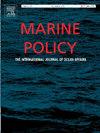Use of conservation areas for fisheries management and ecosystem conservation in the U.S. exclusive economic zone
IF 3.5
2区 社会学
Q2 ENVIRONMENTAL STUDIES
引用次数: 0
Abstract
Area-based restrictions on the use of fishing gears is one of many tools to conserve ecosystems and biodiversity in U.S. waters as well as internationally. We defined the term ‘marine fisheries conservation area’ and created an inventory of areas that restrict fishing activities, most of which were established by the U.S. Fishery Management Councils under the Magnuson-Stevens Fishery Conservation and Management Act (MSA). We identified 648 areas which currently cover 72 % of the total U.S. Exclusive Economic Zone (EEZ). 531 areas, representing 56 % of the EEZ, were classified as Ecosystem Conservation Areas that directly provide in situ conservation of biodiversity. Bottom trawling is prohibited year-round in 56 % of the EEZ, and all bottom tending gear is prohibited year-round in 37 %. Other fishing gears are prohibited in 60 % of the EEZ year-round. Thus, a majority of the U.S. EEZ is conserved from the most environmentally adverse fishing activities. These focused geographic areas complement other management tools used to ensure sustainable fisheries and ecosystems, such as catch and bycatch limits and limitations on legal gears, which are often deployed at regional scales. Collectively, these measures meet objectives and MSA National Standards and promote the maintenance of biological productivity and biodiversity, while balancing ecosystem function with services that benefit our nation, such as access to nature through recreational opportunities and healthy, sustainable seafood for consumers. The strength of fisheries management in the U.S. is the ability to balance the diverse needs of the nation with the need for a healthy marine ecosystem.
在美国专属经济区使用保护区进行渔业管理和生态系统保护
以区域为基础限制渔具的使用是保护美国水域以及国际水域生态系统和生物多样性的众多手段之一。我们定义了“海洋渔业保护区”一词,并创建了限制捕捞活动的区域清单,其中大部分是由美国渔业管理委员会根据《马格努森-史蒂文斯渔业保护和管理法》(MSA)建立的。我们确定了648个区域,目前覆盖了美国专属经济区(EEZ)的72% %。531个区域(占专属经济区的56% %)被划为生态系统保护区,直接提供生物多样性的原位保护。在56% %的专属经济区全年禁止底拖网捕捞,在37% %的专属经济区全年禁止所有底抚鱼具。在60% %的专属经济区全年禁止使用其他渔具。因此,美国大部分专属经济区受到保护,不受最不利于环境的捕捞活动的影响。这些重点地理区域补充了用于确保可持续渔业和生态系统的其他管理工具,例如通常在区域尺度上部署的渔获物和副渔获物限制以及法定年限限制。总的来说,这些措施符合目标和MSA国家标准,促进生物生产力和生物多样性的维护,同时平衡生态系统功能与有益于我们国家的服务,例如通过娱乐机会获得自然和为消费者提供健康,可持续的海鲜。美国渔业管理的优势在于平衡国家多样化需求与健康海洋生态系统需求的能力。
本文章由计算机程序翻译,如有差异,请以英文原文为准。
求助全文
约1分钟内获得全文
求助全文
来源期刊

Marine Policy
Multiple-
CiteScore
7.60
自引率
13.20%
发文量
428
期刊介绍:
Marine Policy is the leading journal of ocean policy studies. It offers researchers, analysts and policy makers a unique combination of analyses in the principal social science disciplines relevant to the formulation of marine policy. Major articles are contributed by specialists in marine affairs, including marine economists and marine resource managers, political scientists, marine scientists, international lawyers, geographers and anthropologists. Drawing on their expertise and research, the journal covers: international, regional and national marine policies; institutional arrangements for the management and regulation of marine activities, including fisheries and shipping; conflict resolution; marine pollution and environment; conservation and use of marine resources. Regular features of Marine Policy include research reports, conference reports and reports on current developments to keep readers up-to-date with the latest developments and research in ocean affairs.
 求助内容:
求助内容: 应助结果提醒方式:
应助结果提醒方式:


